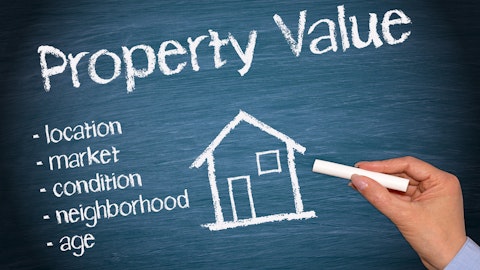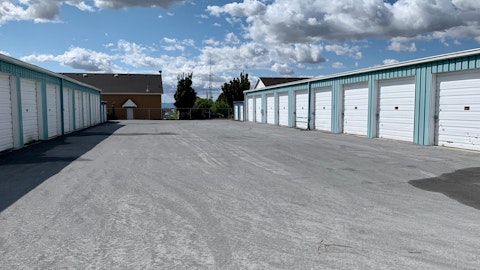Prologis, Inc. (NYSE:PLD) Q3 2023 Earnings Call Transcript October 17, 2023
Operator: Greetings. And welcome to the Prologis Third Quarter 2023 Earnings Conference Call. At this time, all participants are in a listen-only mode. A brief question-and-answer session will follow the formal presentation. [Operator Instructions] As a reminder, this conference is being recorded. It is now my pleasure to introduce your host, Jill Sawyer, Senior Vice President of Investor Relations. Thank you, Jill. You may begin.
Jill Sawyer: Thanks, John, and good morning, everyone. Welcome to our third quarter 2023 earnings conference call. The supplemental document is available on our website at prologis.com under Investor Relations. I’d like to state that this conference call will contain forward-looking statements under federal securities laws. These statements are based on current expectations, estimates and projections about the market and the industry in which Prologis operates, as well as management’s beliefs and assumptions. Forward-looking statements are not guarantees of performance and actual operating results may be affected by a variety of factors. For a list of those factors, please refer to the forward-looking statement notice in our 10-K or other SEC filings.
Additionally, our third quarter results press release and supplemental do contain financial measures such as FFO and EBITDA that are non-GAAP and in accordance with Reg G, we have provided a reconciliation to those measures. I’d like to welcome Tim Arndt, our CFO, who will cover results, real-time market conditions and guidance. Hamid Moghadam, our CEO and our entire executive team are also with us today. With that, I will hand the call over to Tim.
Tim Arndt: Thanks Jill. Good morning, everybody, and thank you for joining our call. The third quarter marked a continuation of themes we have been anticipating for more than a year, namely; growing supply translating to increased market vacancy; continued moderation of demand; and market rent growth that will slow until the low levels of new starts drive reduced availability over-time. We have operated in accordance with these views in both our approach to leasing, as well as timing of new development. What’s incremental to our forecast is that continued hawkish posture from central banks and the impact it’s had on rates is delaying decision-making and willingness to take expansion space early. The geopolitical backdrop has clearly become more troubling as well amounting to a lack of clarity that will likely weigh on demand.
In the meantime, and also playing out to our expectations is that our existing lease mark-to-market will drive durable earnings growth as it did in delivering record rent change this quarter, as well as strong earnings and same-store growth. We remain focused on the fact that we own assets critical to the supply chain with long-term secular drivers that remain intact. Further, the outlook for future supply will continue to face structural barriers, ultimately driving occupancy, rents and values. In terms of our results, we had an excellent quarter with core FFO excluding net promote income of $1.33 per share. This result includes approximately $0.03 of one-time items related to interest and termination income, as well as the timing of expenses, which we can address in Q&A.
Occupancy ticked up over the quarter to 97.5%, aided by retention of 77%. Net effective rent change was a record 84% at our share, with notable contributions from Northern New Jersey at 200%, Toronto at 187% and Southern California at 165%. Same-store growth on a net effective and cash basis was 9.3% and 9.5%, respectively, driven predominantly by rent change. We saw market rents grow roughly 60 basis points during the quarter, the slower pace embedded in our forecast. In combination with the strong build of in-place rents, our lease mark-to-market recalculates to 62% as of September. We raised approximately $1.4 billion in new financings at an average interest rate of 3.2%, comprised principally of $760 million within our ventures, as well as a recast of our Yen credit facility increasing our aggregate line availability.
In combination with our cash position, we ended the quarter with a record $6.9 billion of liquidity. Finally, it’s noteworthy that our debt-to-EBITDA has remained very low and essentially flat all year, hovering in the mid-4 times range, despite our increased financing activity, a demonstration of the tremendous growth in our nominal EBITDA. Turning to our markets, while rising, vacancy remains historically very low in the U.S., Mexico and Europe. Market vacancy increased approximately 70 basis points during the quarter in the U.S., driven by low absorption, as well as recently delivered but unleased completions. Europe experienced similar dynamics with an overall increase in market vacancy of 50 basis points. At the macro level our expectations for the U.S. are for completions to outpace net absorption by a cumulative 150 million square feet to 200 million square feet over the next three quarters.

A large logistic facility within the industrial real estate sector.
Then, over the subsequent three quarters, we see that trend reversing with demand exceeding supply and recovering the net 75 million to 125 million square feet. That trend may extend further into 2025, as we believe development starts over the next several quarters are likely to remain low. Whatever the precise path, we expect that as vacancy normalizes over the long-term, our portfolio will outperform the market due to both its location and quality, as well as the strength of our relationships and operating platform. In this regard, our portfolio has been largely resilient to moderating demand. Our teams would describe the depth of our leasing pipeline as consistent with the last few quarters. In coming fresh off of one of our customer advisory board sessions, it’s clear that our customers have plans to continue to expand their footprint, increasing capacity and resiliency.
However, what’s also clear is that they are slowing such investments until there is more clarity in the economic environment. In the U.S., rents increased in most of our markets with the strongest located in the Sunbelt, Mid-Atlantic and Northern California regions. Europe and Mexico were also bright spots for growth in the quarter. Rents across our Southern California sub-markets declined approximately 2% as it continues to adjust to higher levels of vacancy. While the markets and outlook are mixed, we remain confident in continued market rent growth in the U.S. and globally over the coming year, albeit at a slow pace while the pipeline continues to get absorbed. From our appraisals, U.S. values declined approximately 3% while European values remain stable, in fact, having a very modest write-up.
The difference isn’t too surprising as the Fed’s language around inflation and the economy has had more effect in the U.S. capital markets, driving the 10-year up 100 basis points since our last earnings call, compared to the bund [ph] at just 50 basis points. We believe that this is likely another instance, as we saw one year ago, where U.S. appraisals at the end of the quarter have not had sufficient time to react to the increase in rates and we are thus pausing on appraisal-based activity in USLF for at least one quarter. Elsewhere, values in Mexico are up 8.5%, while China experienced its first meaningful decline of 6.5%, a write-down that we don’t believe has fully run its course. Our funds experienced their first quarter of net positive inflows with approximately $180 million of new commitments versus new redemption requests of $115 million.
Given other activity in the quarter, the net redemptions have been reduced from their height of $1.6 billion to approximately $700 million or roughly 2% of third-party AUMs. In terms of our own deployment, development starts ramped up during the quarter, crossing $1 billion, over half of which is related to a data center opportunity in our central region, a testament to our higher and better use strategy and strategically located land bank. Also notable is the acquisition of $118 million of land, including a strategic parcel in Las Vegas, which will build out an additional 10 million square feet over time and brings our total build-out of land globally to over $40 billion. We are laser focused in identifying and executing on value creation in our core business, our energy business, and their adjacencies.
Combined with the debt capacity and liquidity we have worked hard to build and preserve, we see the environment as rich with opportunity. Moving to guidance, we are increasing the average occupancy to a range between 97.25% and 97.5%. As a result, we are increasing our same-store guidance to a range of 9% to 9.25% on a net effective basis and 9.75% to 10% on a cash basis. We are maintaining our strategic capital revenue guidance, excluding promotes to a range of $520 million to $530 million and adjusting G&A guidance to range between $390 million and $395 million. Our development starts guidance is increased to a new range of $3 billion to $3.5 billion at our share, driven primarily from the data center start mentioned earlier. We have $500 million of contribution and disposition activity during the quarter and given our commentary on USLF valuations, we are pausing our planned contributions into that vehicle this quarter and reducing our combined contribution and disposition guidance to a range of $1.7 billion to $2.3 billion.
In the end, we are adjusting guidance for GAAP earnings to a range of $3.30 per share to $3.35 per share. We are increasing our core FFO, including promotes guidance to a range of $5.58 per share to $5.60 per share and are increasing core FFO, excluding promotes to a range between $5.08 per share and $5.10 per share, growth of nearly 10.5%. I know that many of you are focusing on 2024, so I’d like to take an opportunity to remind you that the Duke portfolio will be entering the same-store pool in 2024, which will widen the recently observed delta between net effective and cash same-store growth. This is, of course, because Duke rents were mark-to-market at close one year ago, so its contribution to net effective same-store growth and earnings will be minimal, even though the cash rent change will be on par with the rest of the Prologis portfolio.
In closing, we are navigating the current environment, assured that whatever the economy brings in the short-term, we are positioned to outperform over the long-term. This stems from not only the premier logistics portfolio and customer franchise with one of the best balance sheets amongst corporates, but also highly visible earnings and portfolio growth ahead of us. We know that turbulent times can bring opportunity for those who are prepared and that’s been central to our strategy and management as a company. I’d like to also remind you of our upcoming Investor Forum on December 13th in New York, our first in four years. We are looking forward to spending the day with you, sharing more about our business, outlook and opportunities ahead.
Additional information is available on our website and in our earnings press release. And with that, I will hand it back to the Operator for your questions.
See also 12 Best Health Insurance Stocks to Buy and 11 Best Quantum Computing Stocks To Buy Now.
Q&A Session
Follow Prologis (Old Insider Filings) (NYSE:PLD)
Follow Prologis (Old Insider Filings) (NYSE:PLD)
Operator: Thank you. [Operator Instructions] And the first question comes from the line of Michael Goldsmith with UBS. Please proceed with your question.
Michael Goldsmith: Good morning. Thanks a lot for taking my question. I mean, Tim, can you help us reconcile some of the comments from the prepared remarks? You talked about maybe softer demand, but then there’s — you are calling for accelerating the number of build-to-suit developments. At the same time, occupancy has been stronger than anticipated and that’s before the lower development starts hit the market. So how should we think about all of these moving pieces and just the trajectory of the supply-demand dynamics as we exit 2023 and into 2024? Thanks.
Tim Arndt: Sure. Demand is definitely softer. It’s closer to normal, maybe even a little bit below normal at this instant. There is a lot of latent demand that large companies having large requirements are continuing to talk to us about build-to-suits, but they are reluctant to pull the [Technical Difficulty]
Operator: And the next question comes from the line of Craig Mailman with Citi. Please proceed with your question.
Craig Mailman: Hey, guys. Let me know if you are having trouble hearing me, because I am having trouble hearing you. But I just wanted to touch on the data center build-to-suits in the quarter and see if you guys could break out what the yields on those were relative to the blended yields on the overall development starts? And maybe just give a little bit more color about the opportunity with your partner on this one, the plan on whether you are going to hold this or anticipate selling it upon completion of that and just a little bit more about the capacity within the land bank to do more of the data center sales?
Operator: Ladies and gentlemen, please remain on the line. We are just having a difficulty here. Thank you. Please remain on the line.
Tim Arndt: I am sorry. We are having some technical difficulties here and I can’t really explain it.
Craig Mailman: Hello.
Tim Arndt: Can you guys hear me? You can hear me again. Okay. So let me finish the first question and then I will go to the second question. To the extent I heard it, which wasn’t great. On the first question, what I wanted to say is that, the data centers account for a pretty significant volume of the build-to-suits and that’s why they are higher. But industrial logistics build-to-suits are kind of in par and in line with our expectations. The reason occupancy is higher, it’s unique to the quality of our portfolio and just the natural role of leases, but market occupancy is slightly lower. So we are outperforming the market by more than we did before. I think that covers the first question. The second question was how should we think about the build-to-suits in terms of its effect on our going in yields and the like, and for that, I am going to turn it over to Dan here.
But generally, we — the build-to-suits strategy of ours is an extension of our higher and best-use strategy. We own a lot of high quality land in markets that are in the path of development and are popular data center markets. And while we may occasionally buy land for data centers, our primary strategy is converting our existing portfolio to data center products to the extent they have power availability. We are getting a lot of people knocking on our door for those opportunities and we think going forward, it’s going to be a pretty significant part of our activity, although it’s lumpy and less prone to precise predictions like the logistic business, but you will hear more about that. Now, strategically, this is important to understand.




